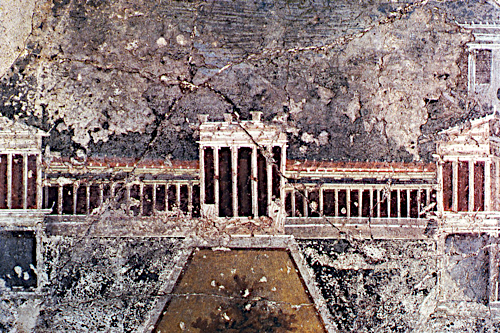Special Topics in History of Art: Romans on Display

This course is designed to engage students in the ongoing preparation of an exhibition entitled "Leisure and Luxury in the Age of Nero: The Villas of Oplontis," currently scheduled to open at the Kelsey Museum of Archaeology in 2016. Oplontis is less than two miles from Pompeii, and is home to one of the 3 or 4 best preserved and most spectacular of the Roman luxury villas that lined the shores of the Bay of Naples from about 50 BC until the eruption of Mount Vesuvius in AD 79. Villa A is often called the Villa of Poppaea on the tenuous assumption that the villa belonged to the family of Poppaea, Nero's second wife. This villa houses some of the most important and splendid Roman wall paintings of the highly illusionistic architectural Second Pompeian Style and some 40 marble sculptures. Representative examples of these paintings and sculptures will be in the exhibition, along with objects of daily life from the villa (pottery, glassware, lamps, incense burner, etc.). In such villas, Rome's "one percent" engaged in entertaining friends and political cronies in a setting of cultivated leisure away from the hectic life of Rome. In their villas wealthy owners put themselves on display amid a backdrop of colonnaded porticoes and gardens populated with sculptures, spacious reception halls, lavish wall paintings and mosaic floors, and other high-end accouterments that communicated their status and power to those they entertained.
Many villas entailed careful management and productive use of the resources of the surrounding land and nearby sea. Excavations at Oplontis have revealed a second structure, known as Villa B, a busy commercial establishment engaged in the lucrative wine trade. An elaborately inlaid storage chest from Villa B suggests that business was very successful. Skeletal remains of fifty-four people, several clutching considerable portable wealth (pearl and emerald-studded gold jewelry, gold and silver coins) were found in a room facing the waterfront, apparently awaiting rescue from the eruption. The exhibition will include the inlaid chest and selected examples jewelry and coins and will raise questions of disparities of wealth and social status.
Students will gain broad background in the types and significance of artworks that created the settings for the lifestyle of elite villa owners (e.g., banqueting, bathing, and the pursuit of intellectual and cultic interests) while participating in developing themes for the exhibition. Presentations and research papers on the objects that will be in the exhibition will consider how to communicate their meaning and importance to a broad public (from scholars through K-12). Students will also engage in developing educational programs for the exhibition.
Textbooks/Other Materials: Reading and other materials for this course will be posted on course CTools site.
Estimated cost of materials: Cost: $0-50. No mandatory field trips outside Ann Arbor.